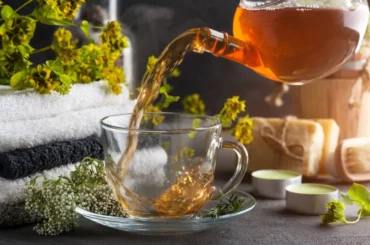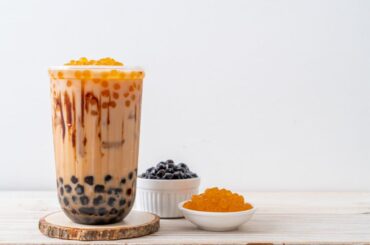Want a stress-relieving, natural drink? How do you create Kava tea?
We will learn how to make Kava tea, a popular South Pacific drink. Knowing how to create Kava tea is interesting, whether you’re a tea expert or just searching for something different to try.
Its relaxing properties come from Piper methysticum, the Kava plant’s roots. Traditional preparation involves crushing the Kava root, steeping it in water, then filtering the liquor. Let’s learn how to make Kava tea step-by-step and discover its mysteries.
What Is Kava Tea?

The South Pacific islands have relied on the therapeutic and ceremonial benefits of the Kava plant for generations. Kavalactones, found in Kava’s roots, are psychotropic chemicals with calming and anxiety-reducing properties. Kava is an integral part of South Pacific culture and is most commonly consumed as a beverage.
Steeping powdered or shredded Kava root in water makes Kava tea. The earthy-tasting tea is relaxing and calming. Kava tea reduces anxiety, relaxes tension, and boosts well-being without impairing cognition. Kava tea, a natural stress reliever, is now consumed worldwide.
What Does Kava Tea Taste Like?
Kava tea is flavorful in its way. Flavors of earth, pepper, and a touch of bitterness are typical descriptors. The flavor is subjective and might change based on the individual, the preparation method, and the quality of the Kava root. Some people compare the taste of Kava tea to muddy water or an herbal infusion with a hint of spiciness.
It is worth noting that while the taste may not be to everyone’s liking initially, many individuals develop an acquired taste for kava tea over time, especially when considering the potential relaxing effects it offers.
Kava Tea Ingredients
Kava tea takes around five to ten minutes to brew, and another twenty to thirty minutes to get the ideal doneness. The amount of Kava root used and the desired strength of the tea both affect the number of serves.
To Prepare Kava Tea, You Will Need The Following Ingredients:

- Kava Root: Kava tea bags typically contain ground root and rhizome of the Kava plant. The root and stem are blended to make a tea-like beverage, usually consumed as a hot drink.
- Water: Water is the base of Kava tea and serves as the medium to extract the active compounds from the Kava root. For the finest possible outcomes, it is necessary to make use of water that is both clean and fresh.
- Milk: Milk is another ingredient that may be added to Kava tea, and doing so can help to smooth out the bitter flavor. Non-dairy alternatives like almond or coconut milk are also popular additions. The cream is another option that can add richness and flavor to the beverage.
- Honey: Adding honey or another sweetener may make Kava tea more pleasant and simpler to drink. However, it’s important not to add too much sugar, as this could minimize the effects of the Kavalactones. Agave nectar and other natural sweeteners are preferable.
- Almond or coconut milk (optional): Adding a splash of either of these milks can make your Kava tea smoother and taste better. It can also give it a hint of a tropical flavor.
- Lemon Juice: Many people enjoy adding lemon juice to Kava tea, as it can help enhance the flavor of the drink. It can also help balance out the bitterness of the Kavalactones, making for a more pleasant drinking experience.
- Ice cubes (optional): Ice cubes can be added to cold Kava tea for a refreshing, icy beverage. It can also help to dilute the taste of the Kavalactones. However, it’s important not to add too much ice as it could water down the flavor.
The combination of Kava root, water, and optional additions, like sweeteners or milk, creates a flavorful and soothing Kava tea. It’s important to note that the quality and sourcing of Kava root can greatly impact the overall taste and effects of the tea.
How To Make A Kava Tea
Kava tea, which is traditionally produced from the plant’s roots and is drunk for its sedative qualities, is a popular beverage. If you’re interested in giving brewing Kava tea at home a try, the instructions below will walk you through making a perfect cup.
- Gather your ingredients: You’ll need Kava root powder, water and, optional, a fat source, like coconut milk or soy lecithin.
- Measure the Kava root powder: Use a measuring spoon to portion out the desired amount of Kava root powder. A common ratio is 1 tablespoon of Kava root powder for every 1 cup of water.
- Prepare the Kava root powder: To keep the powder from contaminating the tea, prepare the kava root by placing it in a muslin bag or a strainer bag. This step is optional, but it helps to create a smoother tea.
- Heat the water: Place a pot on the stove and heat the water. Once it starts boiling gently, wait for a while. Alter the amount of water used based on the number of servings you plan to create.
- Steep the Kava root powder: Once the water reaches a gentle boil, reduce the heat to low and add the Kava root powder-filled bag or strainer into the saucepan. Leave it to simmer for 20 to 30 minutes and stir occasionally.
- Filter the liquid: Take out the bag or strainer from the saucepan and press it to remove any extra liquid. Pour the strained liquid into a bowl or a mug.
- Add a fat source (optional): To enhance the effects of Kava, you can add a small amount of fat to the tea. People often use coconut milk or soy lecithin. Stir it into the Kava tea until well combined.
- Serve and enjoy: Pour the Kava tea into cups or mugs and serve it while still warm. Remember to stir the tea before each sip to ensure an even distribution of the Kava compounds.
It’s important to note that Kava may have different strengths and effects depending on the variety and quality. Kava also possesses a unique flavor that could be described as bitter and earthy. Think about putting in sweeteners or flavorings to change the taste to your liking.
Tips For Making Kava Tea

To ensure a successful and enjoyable experience when making Kava tea, keep these helpful tips in mind. From ingredient selection to brewing techniques, these tips will enhance the quality and taste of your Kava tea.
- High-quality Kava tea leaves: Use the best quality Kava tea leaves to give your cup of Kava a smooth and flavorful taste.
- Boiling time: Boil the water for at least 5 minutes for optimal brewing results.
- Infusion time: Allow the Kava tea leaves to steep for 3 to 5 minutes before removing them from the water.
- Sweeten it up: Sweeten to taste with honey or agave nectar as a sugary finishing touch.
- Adjust sweetness: You can have this tea with minimal sugar by leaving out the sugar syrup. Alternatively, add more syrup for a sweeter drink.
By keeping these tips in mind, you’ll be able to elevate your Kava tea-making skills and create a delightful beverage that meets your preferences. Enjoy the calming effects and embrace the soothing qualities of Kava tea.
Kava Tea Nutritional Facts
Kava tea is prepared from the plant’s roots. Numerous individuals report feeling tranquil after consuming Kava tea, which is also low in calories, carbohydrates, fats, and other macronutrients. Antioxidants, vitamins, and minerals abound in Kava Tea. A single 8-ounce serving of Kava Tea contains approximately:
- Calories: 10kcal
- Carbohydrates: 10g
- Protein: 1g Fat: 0g
- Saturated Fat: 0g
- Cholesterol: 0mg
- Sodium: 48mg
- Potassium: 952mg
- Sugar: 0g
- Calcium: 0mg
Disclaimer: Additional substances can increase the calorie and sugar content of your Kava tea, thereby altering its nutritional value. It is important to note that Kava tea contains an abundance of antioxidants, which may contribute to a variety of health benefits.
Consider these factors when preparing Kava tea, especially if you closely monitor your dietary intake. Then take pleasure in brewing and relishing this delectable beverage while keeping in mind its nutritional value!
Kava Tea Benefits
Kava tea offers a host of potential benefits that make it a popular choice for those seeking a natural and soothing beverage. From promoting relaxation and mental clarity to providing antioxidant support, the benefits of Kava tea extend beyond its calming effects. Discover the positive impacts that Kava tea can have on your well-being and overall health.
- Promotes relaxation: Kava tea has calming properties that can help promote relaxation and reduce stress levels, making it a soothing beverage to unwind with after a long day.
- Supports mental clarity: Kava tea is known for its ability to improve mental focus and alertness, providing a natural boost to cognitive function and enhancing overall mental clarity.
- Rich in antioxidants: The tea leaves used to make Kava tea are extremely rich in antioxidants, which protect cells from harm caused by free radicals and boost health in general.
The benefits mentioned above are based on general knowledge and observations. It is recommended to seek personalized advice from a healthcare professional as individual experiences may differ.
Frequently Asked Questions About Kava Tea
Does Kava Tea Give You a Buzz?
No, Kava tea does not give you a “buzz” like alcohol or caffeine, but many people feel relaxed and more social after drinking it. Some also experience improved mental clarity and heightened focus.
What Is the Best Way To Consume Kava?
Tea form is the most popular way to consume Kava. It can be brewed from fresh or dried root, mixed with water, and often consumed as tea. Kava capsules are another convenient option for those who prefer a quick and easy method of consumption.
What Is the Most Effective Way To Take Kava?
Tea form is the most popular way to consume Kava. It can be brewed from the fresh or dried root, mixed with water, and often consumed as tea. Kava capsules are another convenient option for those who prefer a quick and easy method of consumption.
When Should You Not Take Kava?
Taking Kava if you are pregnant, breastfeeding, or have a medical condition, such as liver disease, is not recommended. Additionally, it is advised to avoid taking Kava alongside other medications or in combination with alcohol.
Can You Brew Kava Like Tea?
Yes, Kava can be brewed like tea. It is typically made with water and either fresh or dried root powder. Kava also comes in convenient capsules if you’d rather not bother with the brewing process.
Can You Drive After Drinking Kava?
Yes, as Kava does not contain alcohol, it is generally safe to drive after drinking Kava tea. You should still be in a fit state to drive and take all required precautions before getting behind the wheel.
Just remember that these are just general ideas and you should always chat with a doctor or medical pro about your own symptoms and situation.




